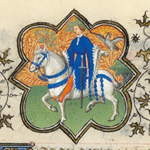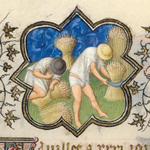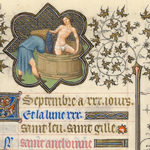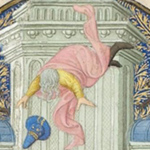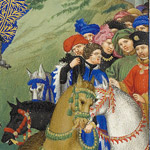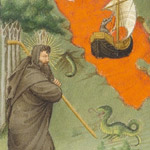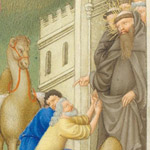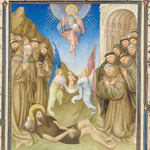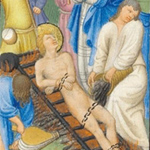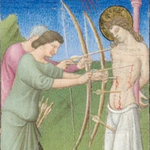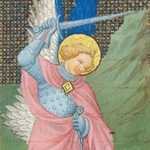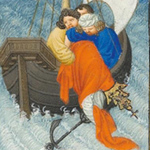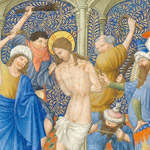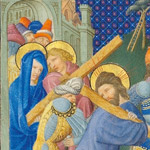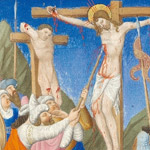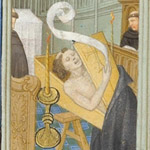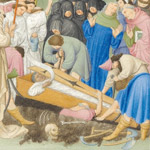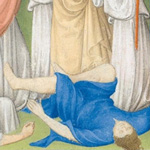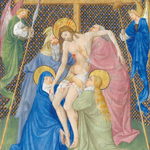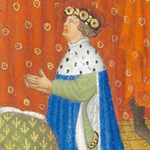Archive for the ‘Manuscript Pages’ Category
Wednesday, June 16, 2010
Above: Details of illuminations from Folio 6r, Folio 8r, and Folio 10r from the Belles Heures of Jean de France, duc de Berry, 1405–1408/9. Herman, Paul, and Jean de Limbourg (Franco-Netherlandish, active in France by 1399–1416). French; Made in Paris. Ink, tempera, and gold leaf on vellum; 9 3/8 x 6 5/8 in. (23.8 x 16.8 cm). The Metropolitan Museum of Art, New York, The Cloisters Collection, 1954 (54.1.1).
The special exhibition The Art of Illumination: The Limbourg Brothers and the Belles Heures of Jean de France, Duc de Berry closed on Sunday, June 13. Thank you for joining me in the discussions of this amazing manuscript. Although I will no longer be writing posts, I encourage you to visit other online resources related to the Museum’s permanent collection of medieval art and The Cloisters, including The Medieval Garden Enclosed, the wonderful blog written by my colleague Deirdre Larkin.
—Wendy A. Stein
Posted in Manuscript Pages | Comments Off
Wednesday, June 9, 2010
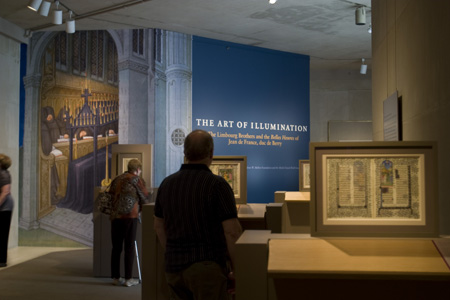
So here we are at the end, with all the sections of the manuscript now posted, and this last chance to reflect. What simple questions may not yet have been asked or answered? What open questions remain for future scholars to ponder, or further studies to publish? Who has come to the exhibition, and who has come to the blog, and what do we all take away? Read more »
Tags: Chris, Christopher de Hamel, conclusion, John Plummer, Judas, Margaret Lawson, Patmos, pigment, Raman spectroscopy, rinceaux, Saint John the Baptist, Saint John the Evangelist, Saint Paul
Posted in Manuscript Pages | Comments (2)
Wednesday, June 2, 2010
Above: Details of illuminations from Folio 211v, Folio 215r, and Folio 223v from the Belles Heures of Jean de France, duc de Berry, 1405–1408/9. Herman, Paul, and Jean de Limbourg (Franco-Netherlandish, active in France by 1399–1416). French; Made in Paris. Ink, tempera, and gold leaf on vellum; 9 3/8 x 6 5/8 in. (23.8 x 16.8 cm). The Metropolitan Museum of Art, New York, The Cloisters Collection, 1954 (54.1.1).
We have come to the final section of the Belles Heures manuscript, mainly a small selection of masses. This is a section that sneaks up on you in interest. It first presents as a traditional element—with most of its text in two columns of black ink—but then inserts a few pages in picture-book format. Like the section dedicated to the Penitential Psalms (Folio 66r through Folio 72r), this one starts out with a series of small quarter-page illuminations, but finishes with magnificently accomplished full-page pictures. Finally, it isn’t fully traditional; not all books of hours contain masses, and their inclusion here leads us into interesting questions about Jean de Berry’s use of his prayerbook. Read more »
Tags: Amiens, Herod, Herodias, Hundred Years' War, mandorla, mass, relic, rinceaux, Saint Catherine, Saint John, Saint Paul, Saint Peter, Salome, Simon Magus, travel
Posted in Manuscript Pages | Comments Off
Wednesday, May 26, 2010
Above: Details of illuminations from Folio 191v, Folio 193r, and Folio 194r from the Belles Heures of Jean de France, duc de Berry, 1405–1408/9. Herman, Paul, and Jean de Limbourg (Franco-Netherlandish, active in France by 1399–1416). French; Made in Paris. Ink, tempera, and gold leaf on vellum; 9 3/8 x 6 5/8 in. (23.8 x 16.8 cm). The Metropolitan Museum of Art, New York, The Cloisters Collection, 1954 (54.1.1).
A self-contained quire of two bifolia, eight pages, presents the story of two hermit saints, Paul and Anthony. This is the last of the full-scale added picture cycles in the manuscript, but it is unlikely to have been the last one to be completed. Compositions in this section are conceived for narrative impact, and their layouts support that purpose rather than spatial coherence. Great and crazy stories are here—scenes you never imagined. Read more »
Tags: aspergillum, Bosch, centaur, corvus, Decius, dove, Grünewald, hermit, Holy Spirit, host, Jerome, Michelangelo, Saint Anthony, Saint Paul, satyr, Schöngauer, situla, temptation, Très Belles Heures
Posted in Manuscript Pages | Comments Off
Wednesday, May 19, 2010
Above: Details of illuminations from Folio 186r, Folio 187r, and Folio 189r from the Belles Heures of Jean de France, duc de Berry, 1405–1408/9. Herman, Paul, and Jean de Limbourg (Franco-Netherlandish, active in France by 1399–1416). French; Made in Paris. Ink, tempera, and gold leaf on vellum; 9 3/8 x 6 5/8 in. (23.8 x 16.8 cm). The Metropolitan Museum of Art, New York, The Cloisters Collection, 1954 (54.1.1).
Now we turn to another great added picture cycle in the Belles Heures, the story of Saint Jerome (ca. 347–420 A.D.). This section of the manuscript traces the saint’s long life from his early interest in classical rhetoric, through his translation of the Bible, to his death and funeral. It includes twelve full-page illuminations replete with unique iconography, extraordinarily subtle modeling, narrative skill, and compositional strength and variety. It also offers a good opportunity for me to discuss the Limbourgs’ spatial construction. Read more »
Tags: Brunelleschi, Cicero, cross-dressing, Florence, Masaccio, orthogonal, perspective, Plato, Saint Jerome, Santa Maria Novella, tessellated, tessera
Posted in Manuscript Pages | Comments Off
Wednesday, May 12, 2010
Above: Details of illuminations from Folio 162v, Folio 165v, and Folio 179r from the Belles Heures of Jean de France, duc de Berry, 1405–1408/9. Herman, Paul, and Jean de Limbourg (Franco-Netherlandish, active in France by 1399–1416). French; Made in Paris. Ink, tempera, and gold leaf on vellum; 9 3/8 x 6 5/8 in. (23.8 x 16.8 cm). The Metropolitan Museum of Art, New York, The Cloisters Collection, 1954 (54.1.1).
Last week I introduced the section of the manuscript with the Suffrages of the Saints—short prayers or memorials to individuals found in many books of hours. As this section can be personalized for the patron in many ways—most simply, in the number and choice of saints included, as well as in the number accorded decoration—it is one place we can look to sense the personality of the patron and artists involved. This week I want to pick out a few more of the individual saints in the Belles Heures, and raise a question that has concerned me for some time: Is this an unusually violent manuscript? Let’s begin by looking at the most violent among the Suffrages. Read more »
Tags: Carolyn Walker Bynum, cephalophore, Johann Huizinga, John the Baptist, Malchus, Montmartre, Porphyrius, Saint Bartholomew, Saint Bruno, Saint Denis, Saint Francis, Saint Margaret, Saint Paul, Saint Peter, Saint Stephen, Saint Ursula, suffrages
Posted in Manuscript Pages | Comments Off
Wednesday, May 5, 2010
Above: Details of illuminations from Folio 158r, Folio 163v, and Folio 173r from the Belles Heures of Jean de France, duc de Berry, 1405–1408/9. Herman, Paul, and Jean de Limbourg (Franco-Netherlandish, active in France by 1399–1416). French; Made in Paris. Ink, tempera, and gold leaf on vellum; 9 3/8 x 6 5/8 in. (23.8 x 16.8 cm). The Metropolitan Museum of Art, New York, The Cloisters Collection, 1954 (54.1.1).
This section of the manuscript contains a microcosm of all the complexity of structure and variety of book design to be found in the Belles Heures. It is a traditional section, yet embedded within it is an added picture-book cycle. It is inconsistent in the level of decoration accorded the various saints: some get no picture, while others get quarter-page or full-page illuminations. The border treatments also vary between narrow and broad bands. It includes stories told in single climactic scenes as well as simple, standing “portraits” of individual saints. In this section, we witness the Belles Heures in transition between a traditional book of hours and the exceptional work it became. Read more »
Tags: Byzantine, Charlemagne, dragon, fleur-de-lis, Heraclius, Heroes Tapestries, Saint Anthony of Padua, Saint Eustace, Saint George, Saint Lawrence, Saint Nicholas, saints, suffrages, True Cross
Posted in Manuscript Pages | Comments Off
Wednesday, April 28, 2010
Above: Details of illuminations from Folio 132r, Folio 138v, and Folio 145r from the Belles Heures of Jean de France, duc de Berry, 1405–1408/9. Herman, Paul, and Jean de Limbourg (Franco-Netherlandish, active in France by 1399–1416). French; Made in Paris. Ink, tempera, and gold leaf on vellum; 9 3/8 x 6 5/8 in. (23.8 x 16.8 cm). The Metropolitan Museum of Art, New York, The Cloisters Collection, 1954 (54.1.1).
As much as a book of hours is about devotion to the Virgin, the heart of the Christian story is still the drama and suffering of the Passion of Christ, a narrative expressively explored in detail in the Belles Heures. Read more »
Tags: crown of thorns, crucifixion, Fra Angelico, Italy, Judas, Longinus, Louvre, Maelwel, Malchus, Malouel, Nicodemus, passion, Peter, Pontius Pilate, The Morgan Library and Museum, underdrawing
Posted in Manuscript Pages | Comments (1)
Wednesday, April 14, 2010
Above: Details of illuminations from Folio 94v, Folio 95r, and Folio 96v from the Belles Heures of Jean de France, duc de Berry, 1405–1408/9. Herman, Paul, and Jean de Limbourg (Franco-Netherlandish, active in France by 1399–1416). French; Made in Paris. Ink, tempera, and gold leaf on vellum; 9 3/8 x 6 5/8 in. (23.8 x 16.8 cm). The Metropolitan Museum of Art, New York, The Cloisters Collection, 1954 (54.1.1).
A self-contained quire of two bifolia inserts another novel picture cycle between traditional sections, and we get to enjoy another display of the Limbourg brothers’ genius. This story is taken from a thirteenth-century Life of Saint Bruno, and like the other added sections, the text is reduced to four lines per page in alternating red and blue ink. It recounts the legend around Saint Bruno’s foundation of the Carthusian order, a reformist monastic sect that allowed individual monks to live as hermits but with some communal elements. Jean de Berry’s brother Philip the Bold, Duke of Burgundy, was a major patron of the Carthusian Order and built its famous monument, the Chartreuse de Champmol in Dijon. (Incidentally, the Chartreuse in Dijon is also where John the Fearless—Philip’s son and Jean de Berry’s nephew—was buried. His tomb featured the carved alabaster figures of mourners now on view at the Met in the special exhibition The Mourners: Tomb Sculpture from the Court of Burgundy.) Read more »
Tags: Bishop Hugo, Bruno, Carthusian, Chartreuse de Champmol, Dijon, Diocrès, hermit, John the Fearless, Philip the Bold, The Office of the Dead
Posted in Manuscript Pages | Comments (5)
Wednesday, April 7, 2010
Above: Details of illuminations from Folio 73v, Folio 80r, and Folio 91r from the Belles Heures of Jean de France, duc de Berry, 1405–1408/9. Herman, Paul, and Jean de Limbourg (Franco-Netherlandish, active in France by 1399–1416). French; Made in Paris. Ink, tempera, and gold leaf on vellum; 9 3/8 x 6 5/8 in. (23.8 x 16.8 cm). The Metropolitan Museum of Art, New York, The Cloisters Collection, 1954 (54.1.1).
It is a jolt to move from the Penitential Psalms, which were among the earliest pages to be painted, to the Institution of the Great Litany, one of the added picture-book cycles created when the Limbourg brothers were more fully developed as artists. The Great Litany was one of the last sections to be completed, and the illuminations represent the artists near the pinnacle of their powers of expressive narration. Here, in a single, inserted bifolium—one sheet of parchment folded to make four pages—we see a great drama of life, death, and faith played out. Read more »
Tags: flagellant, Great Litany, Hours of the Cross, Hours of the Holy Spirit, Pentecost, plague, Pope Gregory, procession, Rome, scourge
Posted in Manuscript Pages | Comments (2)
